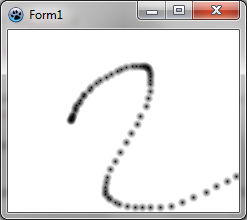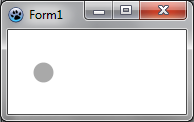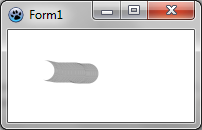Difference between revisions of "BGRABitmap tutorial 3"
(→Continuous drawing: DrawBrush(X,Y,True); 3rd param creates error) |
(→Code: Avoid memory leak in Tutorial 3) |
||
| (One intermediate revision by one other user not shown) | |||
| Line 11: | Line 11: | ||
=== Create a new image === | === Create a new image === | ||
| − | Add a private variable to the main form to store the image : | + | Add a private variable to the main form to store the image: |
| − | <syntaxhighlight> | + | |
| + | <syntaxhighlight lang="pascal"> | ||
| + | TForm1 = class(TForm) | ||
private | private | ||
{ private declarations } | { private declarations } | ||
| Line 18: | Line 20: | ||
public | public | ||
{ public declarations } | { public declarations } | ||
| − | end; </syntaxhighlight> | + | end; |
| + | </syntaxhighlight> | ||
| − | Create the image when the form is created. To do this, double-click on the form, a procedure should appear in the code editor. Add the create instruction : | + | Create the image when the form is created. To do this, double-click on the form, a procedure should appear in the code editor. Add the create instruction: |
| − | <syntaxhighlight>procedure TForm1.FormCreate(Sender: TObject); | + | |
| + | <syntaxhighlight lang="pascal">procedure TForm1.FormCreate(Sender: TObject); | ||
begin | begin | ||
image := TBGRABitmap.Create(640,480,BGRAWhite); //create a 640x480 image | image := TBGRABitmap.Create(640,480,BGRAWhite); //create a 640x480 image | ||
| − | end; </syntaxhighlight> | + | end; |
| + | </syntaxhighlight> | ||
=== Draw the bitmap === | === Draw the bitmap === | ||
| − | Add an OnPaint handler. To do this, select the main form, then go to the object inspector, in the event tab, and double-click on the OnPaint line. Then, add the drawing code : | + | Add an OnPaint handler. To do this, select the main form, then go to the object inspector, in the event tab, and double-click on the OnPaint line. Then, add the drawing code: |
| − | <syntaxhighlight>procedure TForm1.FormPaint(Sender: TObject); | + | |
| + | <syntaxhighlight lang="pascal"> | ||
| + | procedure TForm1.FormPaint(Sender: TObject); | ||
begin | begin | ||
PaintImage; | PaintImage; | ||
| − | end; </syntaxhighlight> | + | end; |
| + | </syntaxhighlight> | ||
| − | Add the PaintImage procedure : | + | Add the PaintImage procedure: |
| − | <syntaxhighlight>procedure TForm1.PaintImage; | + | |
| + | <syntaxhighlight lang="pascal"> | ||
| + | procedure TForm1.PaintImage; | ||
begin | begin | ||
image.Draw(Canvas,0,0,True); | image.Draw(Canvas,0,0,True); | ||
| Line 45: | Line 55: | ||
=== Handle mouse === | === Handle mouse === | ||
| − | With the object inspector, add handlers for MouseDown and MouseMove events : | + | With the object inspector, add handlers for MouseDown and MouseMove events: |
| − | <syntaxhighlight>procedure TForm1.FormMouseDown(Sender: TObject; Button: TMouseButton; | + | |
| + | <syntaxhighlight lang="pascal"> | ||
| + | procedure TForm1.FormMouseDown(Sender: TObject; Button: TMouseButton; | ||
Shift: TShiftState; X, Y: Integer); | Shift: TShiftState; X, Y: Integer); | ||
begin | begin | ||
| Line 56: | Line 68: | ||
begin | begin | ||
if ssLeft in Shift then DrawBrush(X,Y); | if ssLeft in Shift then DrawBrush(X,Y); | ||
| − | end;</syntaxhighlight> | + | end; |
| + | </syntaxhighlight> | ||
| − | Add the DrawBrush procedure : | + | Add the DrawBrush procedure: |
| − | <syntaxhighlight>procedure TForm1.DrawBrush(X, Y: Integer); | + | |
| + | <syntaxhighlight lang="pascal"> | ||
| + | procedure TForm1.DrawBrush(X, Y: Integer); | ||
const radius = 5; | const radius = 5; | ||
begin | begin | ||
| Line 67: | Line 82: | ||
PaintImage; | PaintImage; | ||
| − | end;</syntaxhighlight> | + | end; |
| + | </syntaxhighlight> | ||
After writing this, put the cursor on DrawBrush and press Ctrl-Shift-C to add the declaration to the interface. | After writing this, put the cursor on DrawBrush and press Ctrl-Shift-C to add the declaration to the interface. | ||
| − | This procedure draws as radial gradient (gtRadial) : | + | This procedure draws as radial gradient (gtRadial): |
| + | |||
* the bounding rectangle is (X-radius,Y-radius, X+radius,Y+radius). | * the bounding rectangle is (X-radius,Y-radius, X+radius,Y+radius). | ||
* the center is black, the border is transparent | * the center is black, the border is transparent | ||
| Line 78: | Line 95: | ||
=== Code === | === Code === | ||
| − | <syntaxhighlight>unit UMain; | + | <syntaxhighlight lang="pascal"> |
| + | unit UMain; | ||
{$mode objfpc}{$H+} | {$mode objfpc}{$H+} | ||
| Line 93: | Line 111: | ||
TForm1 = class(TForm) | TForm1 = class(TForm) | ||
procedure FormCreate(Sender: TObject); | procedure FormCreate(Sender: TObject); | ||
| + | procedure FormDestroy(Sender: TObject); | ||
procedure FormMouseDown(Sender: TObject; Button: TMouseButton; | procedure FormMouseDown(Sender: TObject; Button: TMouseButton; | ||
Shift: TShiftState; X, Y: Integer); | Shift: TShiftState; X, Y: Integer); | ||
| Line 116: | Line 135: | ||
begin | begin | ||
image := TBGRABitmap.Create(640,480,BGRAWhite); | image := TBGRABitmap.Create(640,480,BGRAWhite); | ||
| + | end; | ||
| + | |||
| + | procedure TForm1.FormDestroy(Sender: TObject); | ||
| + | begin | ||
| + | image.Free; | ||
end; | end; | ||
| Line 153: | Line 177: | ||
{$I UMain.lrs} | {$I UMain.lrs} | ||
| − | end.</syntaxhighlight> | + | end. |
| + | </syntaxhighlight> | ||
=== Run the program === | === Run the program === | ||
| Line 163: | Line 188: | ||
=== Continuous drawing === | === Continuous drawing === | ||
| − | To have a continuous drawing, we need additionnal variables : | + | To have a continuous drawing, we need additionnal variables: |
| − | <syntaxhighlight> TForm1 = class(TForm) | + | |
| + | <syntaxhighlight lang="pascal"> | ||
| + | TForm1 = class(TForm) | ||
... | ... | ||
private | private | ||
| Line 170: | Line 197: | ||
image: TBGRABitmap; | image: TBGRABitmap; | ||
mouseDrawing: boolean; | mouseDrawing: boolean; | ||
| − | mouseOrigin: TPoint; | + | mouseOrigin: TPoint; |
| + | </syntaxhighlight> | ||
mouseDrawing will be True during the drawing (with left button pressed) and mouseOrigin will be the starting point of the segment being drawn. | mouseDrawing will be True during the drawing (with left button pressed) and mouseOrigin will be the starting point of the segment being drawn. | ||
| − | The clicking handler becomes a little bit more complicated : | + | The clicking handler becomes a little bit more complicated: |
| − | <syntaxhighlight>procedure TForm1.FormMouseDown(Sender: TObject; Button: TMouseButton; | + | |
| + | <syntaxhighlight lang="pascal"> | ||
| + | procedure TForm1.FormMouseDown(Sender: TObject; Button: TMouseButton; | ||
Shift: TShiftState; X, Y: Integer); | Shift: TShiftState; X, Y: Integer); | ||
begin | begin | ||
| Line 184: | Line 214: | ||
DrawBrush(X,Y,True); // or DrawBrush(X,Y); | DrawBrush(X,Y,True); // or DrawBrush(X,Y); | ||
end; | end; | ||
| − | end; </syntaxhighlight> | + | end; |
| − | It initialises the drawing with the current position. Then, it draws as closed segment (note the new parameter for DrawBrush). Indeed, at the beginning, the segment is closed and has a length of zero, which gives a disk : | + | </syntaxhighlight> |
| + | |||
| + | It initialises the drawing with the current position. Then, it draws as closed segment (note the new parameter for DrawBrush). Indeed, at the beginning, the segment is closed and has a length of zero, which gives a disk: | ||
[[Image:BGRATutorial3b.png]] | [[Image:BGRATutorial3b.png]] | ||
| − | Little by little, we add a new part, which is an opened segment : | + | Little by little, we add a new part, which is an opened segment: |
[[Image:BGRATutorial3c.png]] | [[Image:BGRATutorial3c.png]] | ||
| − | That's why we need a new parameter for the DrawBrush function, which becomes : | + | That's why we need a new parameter for the DrawBrush function, which becomes: |
| − | <syntaxhighlight>procedure TForm1.DrawBrush(X, Y: Integer; Closed: Boolean); | + | |
| + | <syntaxhighlight lang="pascal"> | ||
| + | procedure TForm1.DrawBrush(X, Y: Integer; Closed: Boolean); | ||
const brushRadius = 20; | const brushRadius = 20; | ||
begin | begin | ||
| Line 201: | Line 235: | ||
PaintImage; | PaintImage; | ||
| − | end; </syntaxhighlight> | + | end; |
| + | </syntaxhighlight> | ||
We transmit the parameter Closed to DrawLineAntialias, to indicate whether the segment is closed or not. Note coordinates order. The start position and the end position are swapped. Indeed, for DrawLineAntialias, it's the end that is opened, whereas in this case, we want that the beginning be opened. | We transmit the parameter Closed to DrawLineAntialias, to indicate whether the segment is closed or not. Note coordinates order. The start position and the end position are swapped. Indeed, for DrawLineAntialias, it's the end that is opened, whereas in this case, we want that the beginning be opened. | ||
| Line 207: | Line 242: | ||
DrawBrush definition must be updated in the interface. | DrawBrush definition must be updated in the interface. | ||
| − | The MouseMove handler becomes : | + | The MouseMove handler becomes: |
| − | <syntaxhighlight>procedure TForm1.FormMouseMove(Sender: TObject; Shift: TShiftState; X, | + | |
| + | <syntaxhighlight lang="pascal"> | ||
| + | procedure TForm1.FormMouseMove(Sender: TObject; Shift: TShiftState; X, | ||
Y: Integer); | Y: Integer); | ||
begin | begin | ||
if mouseDrawing then DrawBrush(X,Y,False); | if mouseDrawing then DrawBrush(X,Y,False); | ||
| − | end; </syntaxhighlight> | + | end; |
| + | </syntaxhighlight> | ||
| + | |||
| + | Finally, we need to add a MouseUp handler to update mouseDrawing: | ||
| − | + | <syntaxhighlight lang="pascal"> | |
| − | <syntaxhighlight>procedure TForm1.FormMouseUp(Sender: TObject; Button: TMouseButton; | + | procedure TForm1.FormMouseUp(Sender: TObject; Button: TMouseButton; |
Shift: TShiftState; X, Y: Integer); | Shift: TShiftState; X, Y: Integer); | ||
begin | begin | ||
if Button = mbLeft then | if Button = mbLeft then | ||
mouseDrawing := False; | mouseDrawing := False; | ||
| − | end; | + | end; |
| + | </syntaxhighlight> | ||
=== Code === | === Code === | ||
| − | <syntaxhighlight>unit UMain; | + | <syntaxhighlight lang="pascal"> |
| + | unit UMain; | ||
{$mode objfpc}{$H+} | {$mode objfpc}{$H+} | ||
| Line 314: | Line 356: | ||
{$I UMain.lrs} | {$I UMain.lrs} | ||
| − | end.</syntaxhighlight> | + | end. |
| + | </syntaxhighlight> | ||
=== Run the program === | === Run the program === | ||
| − | Now the drawing is almost continous : | + | Now the drawing is almost continous: |
[[Image:BGRATutorial3d.png]] | [[Image:BGRATutorial3d.png]] | ||
Latest revision as of 20:24, 13 February 2023
│ Deutsch (de) │ English (en) │ español (es) │ français (fr) │
Home | Tutorial 1 | Tutorial 2 | Tutorial 3 | Tutorial 4 | Tutorial 5 | Tutorial 6 | Tutorial 7 | Tutorial 8 | Tutorial 9 | Tutorial 10 | Tutorial 11 | Tutorial 12 | Tutorial 13 | Tutorial 14 | Tutorial 15 | Tutorial 16 | Edit
This tutorial shows you how to draw on a bitmap with the mouse.
Create a new project
Create a new project and add a reference to BGRABitmap, the same way as in the first tutorial.
Create a new image
Add a private variable to the main form to store the image:
TForm1 = class(TForm)
private
{ private declarations }
image: TBGRABitmap;
public
{ public declarations }
end;
Create the image when the form is created. To do this, double-click on the form, a procedure should appear in the code editor. Add the create instruction:
procedure TForm1.FormCreate(Sender: TObject);
begin
image := TBGRABitmap.Create(640,480,BGRAWhite); //create a 640x480 image
end;
Draw the bitmap
Add an OnPaint handler. To do this, select the main form, then go to the object inspector, in the event tab, and double-click on the OnPaint line. Then, add the drawing code:
procedure TForm1.FormPaint(Sender: TObject);
begin
PaintImage;
end;
Add the PaintImage procedure:
procedure TForm1.PaintImage;
begin
image.Draw(Canvas,0,0,True);
end;
After writing this, put the cursor on PaintImage and press Ctrl-Shift-C to add the declaration to the interface.
Handle mouse
With the object inspector, add handlers for MouseDown and MouseMove events:
procedure TForm1.FormMouseDown(Sender: TObject; Button: TMouseButton;
Shift: TShiftState; X, Y: Integer);
begin
if Button = mbLeft then DrawBrush(X,Y);
end;
procedure TForm1.FormMouseMove(Sender: TObject; Shift: TShiftState; X,
Y: Integer);
begin
if ssLeft in Shift then DrawBrush(X,Y);
end;
Add the DrawBrush procedure:
procedure TForm1.DrawBrush(X, Y: Integer);
const radius = 5;
begin
image.GradientFill(X-radius,Y-radius, X+radius,Y+radius,
BGRABlack,BGRAPixelTransparent, gtRadial,
PointF(X,Y), PointF(X+radius,Y), dmDrawWithTransparency);
PaintImage;
end;
After writing this, put the cursor on DrawBrush and press Ctrl-Shift-C to add the declaration to the interface.
This procedure draws as radial gradient (gtRadial):
- the bounding rectangle is (X-radius,Y-radius, X+radius,Y+radius).
- the center is black, the border is transparent
- the center is at (X,Y) and the border at (X+radius,Y)
Code
unit UMain;
{$mode objfpc}{$H+}
interface
uses
Classes, SysUtils, FileUtil, LResources, Forms, Controls, Graphics, Dialogs,
BGRABitmap, BGRABitmapTypes;
type
{ TForm1 }
TForm1 = class(TForm)
procedure FormCreate(Sender: TObject);
procedure FormDestroy(Sender: TObject);
procedure FormMouseDown(Sender: TObject; Button: TMouseButton;
Shift: TShiftState; X, Y: Integer);
procedure FormMouseMove(Sender: TObject; Shift: TShiftState; X, Y: Integer);
procedure FormPaint(Sender: TObject);
private
{ private declarations }
image: TBGRABitmap;
procedure DrawBrush(X, Y: Integer);
procedure PaintImage;
public
{ public declarations }
end;
var
Form1: TForm1;
implementation
{ TForm1 }
procedure TForm1.FormCreate(Sender: TObject);
begin
image := TBGRABitmap.Create(640,480,BGRAWhite);
end;
procedure TForm1.FormDestroy(Sender: TObject);
begin
image.Free;
end;
procedure TForm1.FormMouseDown(Sender: TObject; Button: TMouseButton;
Shift: TShiftState; X, Y: Integer);
begin
if Button = mbLeft then DrawBrush(X,Y);
end;
procedure TForm1.FormMouseMove(Sender: TObject; Shift: TShiftState; X,
Y: Integer);
begin
if ssLeft in Shift then DrawBrush(X,Y);
end;
procedure TForm1.FormPaint(Sender: TObject);
begin
PaintImage;
end;
procedure TForm1.DrawBrush(X, Y: Integer);
const radius = 20;
begin
image.GradientFill(X-radius,Y-radius, X+radius,Y+radius,
BGRABlack,BGRAPixelTransparent,gtRadial,
PointF(X,Y), PointF(X+radius,Y), dmDrawWithTransparency);
PaintImage;
end;
procedure TForm1.PaintImage;
begin
image.Draw(Canvas,0,0,True);
end;
initialization
{$I UMain.lrs}
end.
Run the program
You should be able to draw on the form.
Continuous drawing
To have a continuous drawing, we need additionnal variables:
TForm1 = class(TForm)
...
private
{ private declarations }
image: TBGRABitmap;
mouseDrawing: boolean;
mouseOrigin: TPoint;
mouseDrawing will be True during the drawing (with left button pressed) and mouseOrigin will be the starting point of the segment being drawn.
The clicking handler becomes a little bit more complicated:
procedure TForm1.FormMouseDown(Sender: TObject; Button: TMouseButton;
Shift: TShiftState; X, Y: Integer);
begin
if Button = mbLeft then
begin
mouseDrawing := True;
mouseOrigin := Point(X,Y);
DrawBrush(X,Y,True); // or DrawBrush(X,Y);
end;
end;
It initialises the drawing with the current position. Then, it draws as closed segment (note the new parameter for DrawBrush). Indeed, at the beginning, the segment is closed and has a length of zero, which gives a disk:
Little by little, we add a new part, which is an opened segment:
That's why we need a new parameter for the DrawBrush function, which becomes:
procedure TForm1.DrawBrush(X, Y: Integer; Closed: Boolean);
const brushRadius = 20;
begin
image.DrawLineAntialias(X,Y,mouseOrigin.X,mouseOrigin.Y,BGRA(0,0,0,128),brushRadius,Closed);
mouseOrigin := Point(X,Y);
PaintImage;
end;
We transmit the parameter Closed to DrawLineAntialias, to indicate whether the segment is closed or not. Note coordinates order. The start position and the end position are swapped. Indeed, for DrawLineAntialias, it's the end that is opened, whereas in this case, we want that the beginning be opened.
DrawBrush definition must be updated in the interface.
The MouseMove handler becomes:
procedure TForm1.FormMouseMove(Sender: TObject; Shift: TShiftState; X,
Y: Integer);
begin
if mouseDrawing then DrawBrush(X,Y,False);
end;
Finally, we need to add a MouseUp handler to update mouseDrawing:
procedure TForm1.FormMouseUp(Sender: TObject; Button: TMouseButton;
Shift: TShiftState; X, Y: Integer);
begin
if Button = mbLeft then
mouseDrawing := False;
end;
Code
unit UMain;
{$mode objfpc}{$H+}
interface
uses
Classes, SysUtils, FileUtil, LResources, Forms, Controls, Graphics, Dialogs,
BGRABitmap, BGRABitmapTypes;
type
{ TForm1 }
TForm1 = class(TForm)
procedure FormCreate(Sender: TObject);
procedure FormMouseDown(Sender: TObject; Button: TMouseButton;
Shift: TShiftState; X, Y: Integer);
procedure FormMouseMove(Sender: TObject; Shift: TShiftState; X, Y: Integer);
procedure FormMouseUp(Sender: TObject; Button: TMouseButton;
Shift: TShiftState; X, Y: Integer);
procedure FormPaint(Sender: TObject);
private
{ private declarations }
image: TBGRABitmap;
mouseDrawing: boolean;
mouseOrigin: TPoint;
procedure DrawBrush(X, Y: Integer; Closed: boolean);
procedure PaintImage;
public
{ public declarations }
end;
var
Form1: TForm1;
implementation
{ TForm1 }
procedure TForm1.FormCreate(Sender: TObject);
begin
image := TBGRABitmap.Create(640,480,BGRAWhite);
end;
procedure TForm1.FormMouseDown(Sender: TObject; Button: TMouseButton;
Shift: TShiftState; X, Y: Integer);
begin
if Button = mbLeft then
begin
mouseDrawing := True;
mouseOrigin := Point(X,Y);
DrawBrush(X,Y,True);
end;
end;
procedure TForm1.FormMouseMove(Sender: TObject; Shift: TShiftState; X,
Y: Integer);
begin
if mouseDrawing then DrawBrush(X,Y,False);
end;
procedure TForm1.FormMouseUp(Sender: TObject; Button: TMouseButton;
Shift: TShiftState; X, Y: Integer);
begin
if Button = mbLeft then
mouseDrawing := False;
end;
procedure TForm1.FormPaint(Sender: TObject);
begin
PaintImage;
end;
procedure TForm1.DrawBrush(X, Y: Integer; Closed: Boolean);
const brushRadius = 20;
begin
image.DrawLineAntialias(X,Y,mouseOrigin.X,mouseOrigin.Y,BGRA(0,0,0,128),brushRadius,Closed);
mouseOrigin := Point(X,Y);
PaintImage;
end;
procedure TForm1.PaintImage;
begin
image.Draw(Canvas,0,0,True);
end;
initialization
{$I UMain.lrs}
end.
Run the program
Now the drawing is almost continous:
Previous tutorial (image loading) | Next tutorial (direct pixel access)



